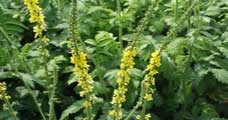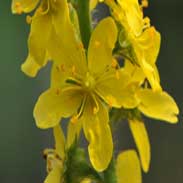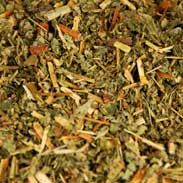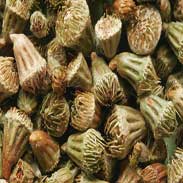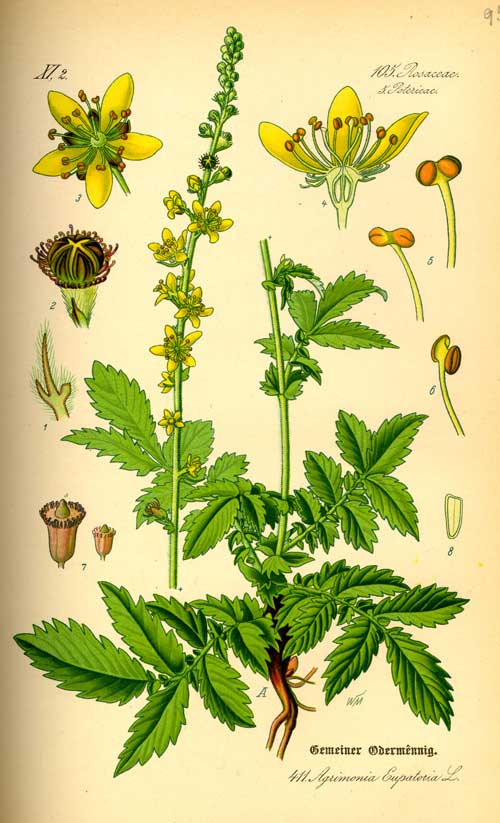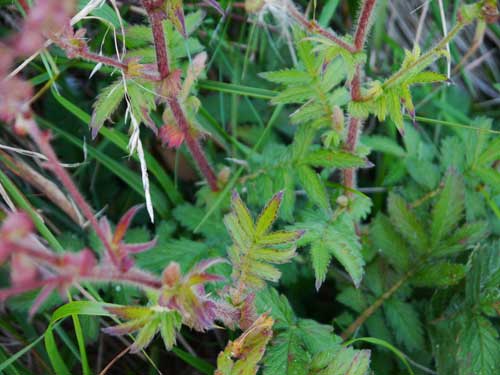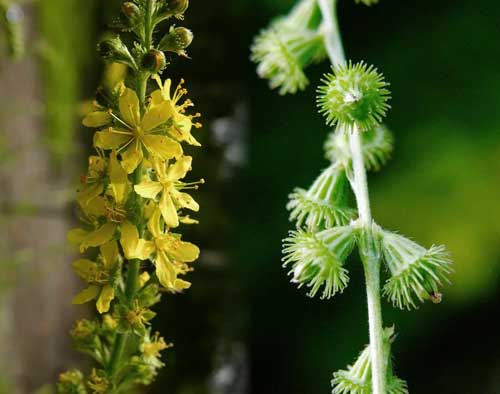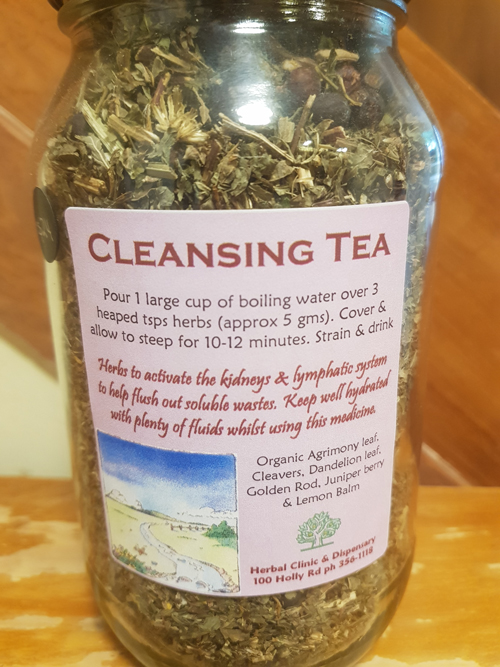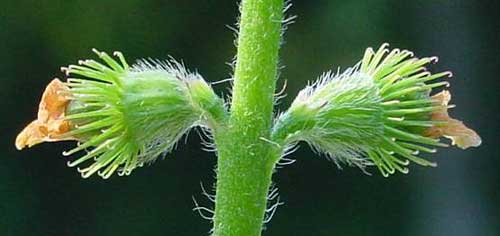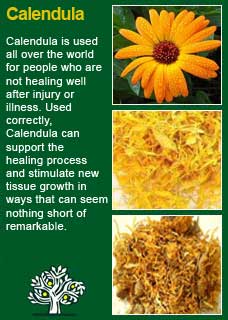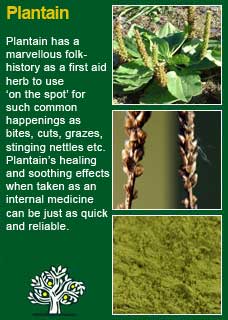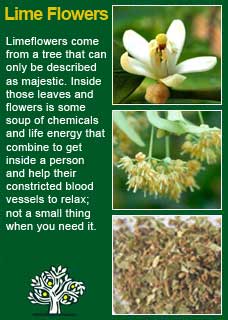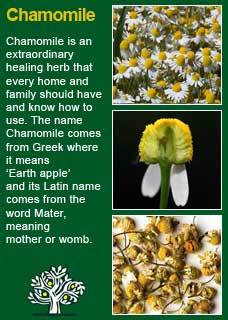
|
|
||||
| Our Pages ABOUT CONSTITUTIONAL MEDICINE
|
The dried leaves of Agrimony, a perennial, deep-green herb covered with soft hairs and with a mild, pleasantly aromatic scent. Agrimony has burrs that have the ability to catch onto wool or clothing and it can grow to nearly a metre tall bearing beautiful long spikes of bright yellow flowers.
The name Agrimony is derived from the Greek 'argemone' which was a word that was used to denote a herb that was good for the eyes. Agrimony has been used as a 'spring drink' to help with cleansing and in some parts of the world it is drunk with meals as a refreshing and pleasant beverage. Pliny the Elder described Agrimony as a 'herb of sovereign power.' The English herbalist Gerard said of Agrimony 'a decoction of the leaves is good for them that have naughty livers' and the Roman physician Dioscorides said that it was 'not only a remedy for them that have bad livers but also for those who are bitten by serpents' From King's Dispensatory, 1898: Agrimony is a mild tonic, alterative, and astringent. A decoction of it is highly recommended in bowel complaints, leucorrhoea, chronic mucous diseases, chronic affections of the digestive organs, profuse bleedings, of an asthenic character, certain cutaneous diseases, icterus, etc. A strong decoction, sweetened with honey, is reputed curative in scrofula, if its use be persisted in for a length of time; and it has also been highly extolled in the treatment of gravel, asthma, coughs, and obstructed menstruation. David Hoffmann writes that 'the combination of astrigency and bitter properties makes this herb a valuable remedy... Agrimony may be used to treat indigestion, and is a specific for childhood diarrhoea. It is the herb of choice for early-stage appendicitis, and its properties give it a role in the treatment of mucous colitis' Thomas Bartram says of Agrimony that it 'helps the assimilation of food and is good for indigestion, weak acid stomach and a sluggish liver.' Simon Mills says Agrimony is good for 'irritations and infections of the intestinal tract, especially in children, and for gall-bladder disease associated with gastric hyperacidity' Priest and Priest described Agrimony as 'a gently stimulating tonic with a gastro-intestinal emphasis that is suitable for both infants and the elderly. It influences mucus membranes, promotes assimilation and restores debilitated conditions' They also cite Agrimony as combining well with Shepherd's purse and Corn Silk for weak or stressed kidneys or for bedwetting and with Meadowsweet for hyperacidic dyspepsia. Although these days it is hardly thought of as having properties that affect the nerves Agrimony was once upon a time highly regarded for its ability to help achieve a deep and restful sleep. An ancient rhyme went:
~ A member of the Rose family; Agrimony is rich in bitters, mucilage, phytosterols and tannins. The constituents of agrimony include acids such as palmitic acid, salicylic acid, silicic acid and stearic acid; flavonoids such as apigenin, glycosides, kaempferol, luteolin-7-glucoside, quercetin, and quercitrin; tannins (3-21%) such as agrimoniin, ellagitannin and gallotannin. ~ Studies have shown that agrimony has insulin-like effects and helped to reduce symptoms of hyperglycaemia. Results demonstrated the presence of antihyperglycemic, insulin-releasing and insulin-like activity in Agrimony eupatoria (Gray AM, Flatt PR. Actions of the traditional anti-diabetic plant, Agrimony eupatoria (agrimony): effects on hyperglycaemia, cellular glucose metabolism and insulin secretion. Br J Nutr 1998;80:109-14) ~ Agrimony extracts were shown to have antiviral activity against human herpes simplex virus, attributed to polyphenols in the herb. ( Li Y, Ooi LS, Wang H, et al. Antiviral activities of medicinal herbs traditionally used in southern mainland China. Phytother Res 2004;18(9):718-722) ~ Many skin conditions, wounds and bruises, have been anecdotally treated with agrimony. However, there have been few clinical trials in humans to support these claims A study in a group of 20 patients found agrimony infusions to be successful in treating cutaneous porphyria, a rather gnarly chronic, skin condition. A significant improvement in skin eruptions together with a decrease in urinary porphyrins was noted (Patrascu V, Chebac PI. [Favorable therapeutic results in cutaneous porphyria obtained with Agrimonia eupatoria]. Revista De Medicina Interna Neurologie Psihiatrie Neurochirurgie Dermato Venerologie Serie Dermato Venerologia 1984;29(2):153-157) ~ Anecdotally, agrimony has been used for many gastrointestinal conditions such as appendicitis, mild diarrhea, stimulation of appetite and ulcers. A clinical trial using a compound herb preparation with Agrimonia eupatoria, Hypericum perforatum, Plantago major, Mentha piperita, and Matricaria chamomilla was used to treat 35 patients suffering from chronic gastroduodenitis. After 25 days of therapy, 75% of patients claimed to be free from pain, 95% from dyspeptic symptoms and 76% from palpitation pains. Gastroscopy was said to indicate that previous erosion and hemorrhagic mucous changes had healed. No side effects or signs of toxicity were documented. (PETROVSKII GA, ZAPADNIUK VI, PASECHNIK IK, et al. [Cholagogue effect of Bupleurum exaltatum, Agrimonia asiatica, Leontopodium ochroleucum, and Veronica virginica.]. Farmakol Toksikol 1957;20(1):75-77) ~ The authors, titles and the 'where-and-when' published of over 20 studies and articles on Agrimony are listed in a PDF found here
In theory, Agrimony could help people with diabetes because it appears to lower blood sugar levels, but it may be wise to not go too long without food if using this herb in regular medicinal doses. Also, if taking medications to lower blood glucose, it would be prudent to keep a close check on your blood sugar levels when taking Agrimony. That said, if it does indeed lower them further then you might think about taking less of the drug than the herb! There is no reason to expect that Agrimony teas or tincture will be any risk to take whilst pregnant or breastfeeding, likewise it can be used with confidence by all ages.
For some years now, against this proven and safe way of herbalism, there has been a rising tide of excessive caution and scare-mongering in many parts of the world. The same authorities that, not so long ago, decried herbal medicines as ineffectual, have now taken up a different adversarial position; that they are dangerous substances that should only be prescribed by Doctors, who of course have zero training in them. Unfortunately, the same unnecessary fear and worry has crept into many natural health websites and popular publications on herbs. Herbs that we have safely used for thousands of years, that have no reports of adverse reactions in the medical literature despite widespread use by millions of people, are suddenly described as contraindicated because of something that should have been seen as completely unimportant, or at the utmost a merely theoretical concern, such as a laboratory study on one of the herb's constituents to use an all too common example. I wonder sometimes if the writers of such articles feel that the herb will be more deserving of respect if it is thought to be a little bit dangerous, in other words more like a drug than something that has simply come out of the earth and been used by ordinary people for generations beyond count. There is just so much misinformation about herbal medicine on the internet now. Ludicrous claims and cautions abound in equal measure; it seems like one group are trying to make money out of the public whilst the other are busily trying to scare them off. I have to believe that the kind of reader who takes the time to read pages on herbs that are as extensive as this one is much less likely to be swayed by marketers or misinformers. I hope that you will keep your wits about you if you get conflicting opinions from people who have never really got to know these herbs, who have never worked with them, or learned how to use them safely and effectively. I want to remind you that the reason that herbs can never be patented and owned by any individual or corporation is because they are, and always will be, the People's medicine. They belong to all of us and it is my great hope in sharing this work that you will learn how to use them wisely for yourself, and the people you care for. Be safe, but do not be afraid.
Agrimony is excellent to use in a tea form where even just a tsp or two of the dried herb steeped in a cup of freshly boiled water for 5-10 minutes conveys a healing action that is deep, mild and easily received. How Agrimony works on the inside is just how it works on the outside and a way to immediately experience how soothing and healing a herb Agrimony can be is where one or both of the eyes are burning or itchy. Here you might take some of the freshly made but sufficiently cooled tea and either place some drops directly into the eye or use in an eye-cup to bathe the eye. It is likely that significant instant relief will be experienced, and such a treatment could be repeated as often as needed until the condition resolved. Similarly, one can quickly see its healing action on the skin if there are hives or some other kind of inflammatory eruption. In such case you can make a tea of Agrimony using 5 or 6 heaped tsps to 2 cups of boiling water, covered and allowed to steep for 15 minutes, then strain and allow to cool. This tea can be sprayed or dabbed on to any affected areas for some immediate soothing effects. If you who are reading this are studying herbal medicine or have your own reasons to want to understand this plant ally at a much deeper level then I warmly encourage you to take a cup of Agrimony leaf tea of a small dose of its tincture and then, with a quiet and attentive mind, observe for yourself how it makes you feel. This old method of 'experiential' learning may give you a greater appreciation of the herb's 'action' than you could ever glean by reading about it. Further to that, if you would like to learn more about the ancient art of pulse testing, a simple but powerful way to ask the intuitive intelligence of the body for its responses to a herb by feeling the pulse whilst giving a tiny dose by mouth, read here Speaking for myself I can feel a rather lovely spreading effect from the herb that starts in my throat and slowly moves down into my chest and upper abdomen. Feeling its action in such a way helps me to understand how Agrimony can bring tone to tissues. In practice, I especially like to use Agrimony for people who have had long-standing problems in their liver, kidneys or digestive health. Two of the most common ways I use it are shown in example of a gut-healing formula and a cleansing tea below. Dosage is always crucial to using herbs effectively. Some authors recommend higher amounts and one should be open to experimenting to see what works best but my own view on this is that the dosage to get the benefits of Agrimony do not have to be very high; a tsp or two of the dried herb, a ml or two of the extract which, in our clinic, we prepare as a 1:5 tincture in 40% ethanol.
To make 210 mls, which will easily fit into a 200ml amber pharm round bottle. Bearing in mind that these would be tinctures that we make in our clinic, therefore herbal extracts from other companies or practitioners might have a different range, the dose I would give for a sure action on healing a damaged gut would be 4-5 mls, 2-3 times daily for as long as needed.
These are all dried herb weights. If at all possible, get the herbs from a certified organic supplier, there is usually a very significant difference in quality and, if we all support the organic herb world, it will continue to flourish and remain affordable for all. These amounts will give 300grams, enough to fill 2 jars of the one pictured below. Taken at full strength, this amount would give enough cleansing tea to last close to a month of daily doses.
For a potent cleansing action, pour two large cups of freshly boiled water over 10grams or 6 very heaped tsps of the herbs. Cover and allow to steep for a good 10-12 minutes. Steeping much longer than this will not make the tea more medicinal, but it will make the tea harder to drink! Strain and drink the tea in divided doses through the day. The tea will keep fresh and strong for 24 hours and it will not affect its potency if it is allowed to cool however, if you prefer it warm or hot, then strain the tea into a thermos when you make it rather than re-heat it later. I suggest you use all the cleansing tea well before dinner time to allow your kidneys time to cool off before you go to bed for the night. You can, for example, simply divide the dose in two and have one cup in the morning and one in the afternoon, but if you prefer to divide it further or even to mix the tea into a drinking bottle and take it ‘on the go’ with you then that’s ok too. Adding honey while it still hot is optional and will not affect the action of the herbs and likewise it is ok if you want to mix the tea with any kind of juice if that is your preference. What this means is that if you don’t drink enough additional fluids during this stage of the treatment then you will be likely to feel some combination of irritability or physical achiness. Therefore, it is important that, once you get this process started, you regularly rehydrate and the way to be sure you are doing this sufficiently is to keep a check that you are going to pass a good amount of urine at a minimum of once every two hours. Going to the toilet more than once an hour is an unnecessary level of strain on the kidneys and you should ease back your additional fluids if this is happening to you. The sweet spot is to have a good flow of urine coming through every 1 to 2 hours.
"The taste of agrimony is sweet, acrid, and a little bitter. I often have the client taste the herb, just a drop of tincture or a sip of decoction, if agrimony tastes sweet, then there's a good chance they will respond positively to the tension-relieving properties of the herb. If it tastes acrid, then they will more than likely respond to the astringent properties.
Much of the information here about the traditional uses of Agrimony is consistent with the model of thinking whereby one may treat problem A with plant B. There is value in this approach, especially in how it helps us pass on useful knowledge to one another, but it falls short in one vital area; and that is that people are not all cut from the same cloth! Something that works brilliantly for one person may do less for another -- why is this? Part of the reason is that people vary in their constitutions as to whether they are either hotter or cooler and, at the same time, either dryer or damper. This useful and rather fascinating subject is introduced further here Another big part of using the right herb when it is most needed comes from understanding the need to treat what is going wrong for the person that had led up to their getting a health condition. In this light, Agrimony shows itself as a gentle, toning herb that can particularly offer its benefits when a nourishing action is needed in the 'cycle of healing' - more about that here
Please understand that I cannot advise you, including on products or dosage, without seeing you in person in my clinic but for ideas
on how you might find a good herbalist in your area read here |
|
|
© 2011 R.J.Whelan Ltd
